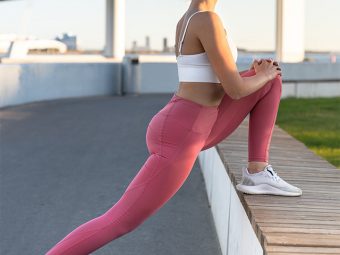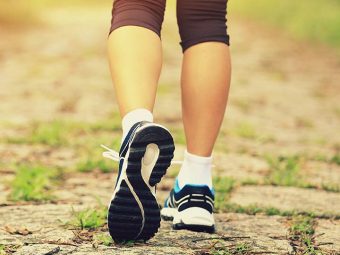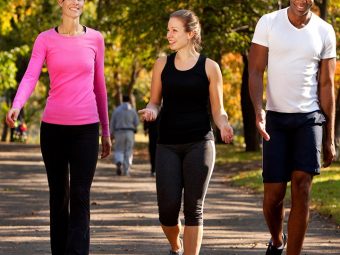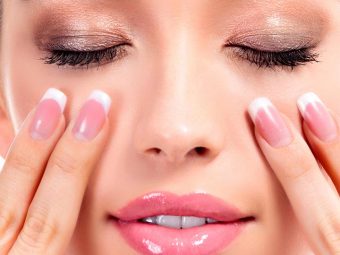20 Amazing Benefits Of Physical Exercises For A Healthy Life
Regular physical workouts can have benefits that compound over time.
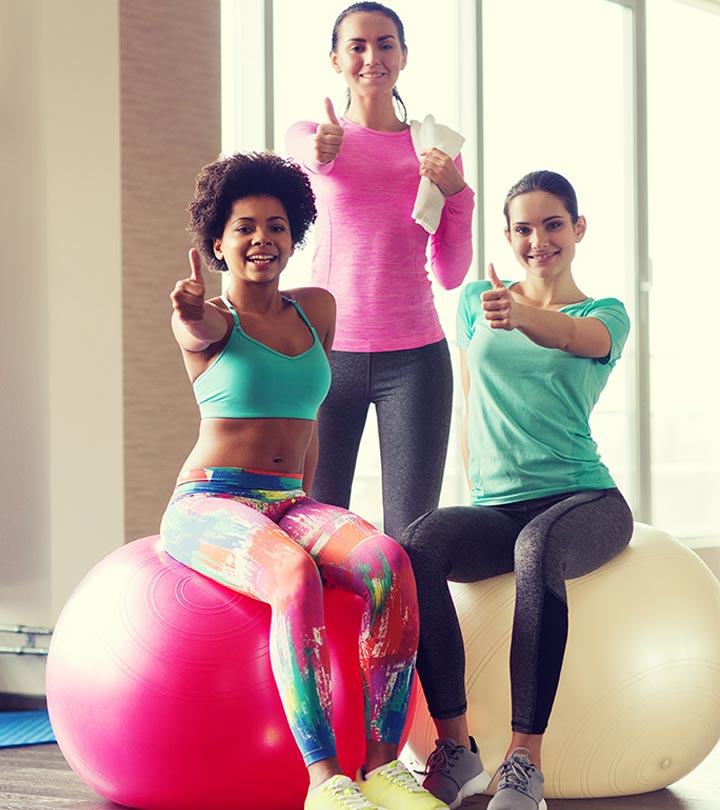
Staying active is ideal for keeping health issues at bay. There are many benefits of physical exercise. It can help reduce the risk of a plethora of diseases (1), (2), (3). For people aged between 6 and 65, the WHO recommends one to three hours of exercise per week (4). Even 15 to 30 minutes of brisk walking, running, dancing, playing a sport, or strength training every day helps improve heart rate, muscle strength, immunity, and overall mental wellbeing (5). Check out the full list of the benefits of physical exercise here.
In This Article
20 Benefits Of Exercise
1. Protects You From Cardiovascular Disease
It is not breaking news that cardiovascular disease is one of the leading causes of death. And that’s unfortunate. According to the American Heart Association, by 2030, the prevalence of cardiovascular diseases is going to increase by 9.9% (6). But scientists from around the globe agree that the mortality rate due to CVD can be reduced by regular exercising (7).
2. Aids Weight Loss
Physical exercise, coupled with proper nutrition, is the best way to lose weight (8). If you are borderline overweight, overweight, or obese, you must start exercising. It will help you shed the extra pounds by converting the excess calories into usable energy, which you need to breathe, talk, walk, exercise, and carry out various cellular functions. By losing weight, you will be able to ward off many obesity-related diseases.
3. Reduces The Risk Of Type 2 Diabetes
Insulin resistance is when the body no longer responds to insulin. It causes an increased production of insulin by the pancreas. Since insulin promotes weight gain, an excessive amount of insulin production can lead to weight gain. Being overweight or obese increases your risk of insulin resistance. And that may lead to diabetes. Scientists have confirmed that regular physical exercise can reduce the risk of diabetes by 58% in high-risk population (9).
4. Strengthens Muscles And Bones
The health of your muscles and bones is very important. As you start aging, typically after 30 years, you start losing muscle mass and bone density. And that’s the reason many women above 30 suffer from loose skin, joint pain, and osteoporosis. Research reveals that strength training improves the mineral density of the bones, thereby protecting you from osteoporosis (10). In fact, strength training also helps improve muscle mass, muscle power, and muscle endurance (11).
5. Reduces Stress
If you are stressed, you should exercise. Stress not only hampers your sleep at night but also impairs your immune functions (12). Stress also leads to excess accumulation of harmful oxygen radicals in the body, which, in turn, leads to other diseases (13). Physical activity is highly beneficial in reducing stress. Whenever you feel stressed out, take a walk or run, and you will soon see a change in your mood.
6. Effective Treatment For Depression And Anxiety
Depression and anxiety are serious mental health issues, and you should not ignore them. Apart from taking medical advice, you must start exercising. Exercise helps release serotonin, the “feel good” hormone that helps uplift your mood. Norwegian scientists conducted an experiment with 977 patients and found that physical exercise improved the mood of depressed patients (14).
7. Lowers High Blood Pressure
High blood pressure can lead to heart attack, stroke, and even death. And it is mainly caused due to bad eating habits, a sedentary lifestyle, and/or inherited genes. If you suffer from hypertension or high blood pressure, you must take care of your diet and start exercising. Scientists studied about 800 people with high blood pressure for six months and found that exercising for 30 to 60 minutes, 3 to 7 days a week helped lower systolic blood pressure (15).
8. Reduces Risk Of Cancer
Cancer is one of the leading causes of death. It is caused due to faulty genes synthesizing faulty proteins, leading to uncontrollable cell division. It becomes dangerous when the cells metastasize and affect other body parts. Regular exercising not only helps reduce the risk of cancer but also has a positive effect on people undergoing cancer treatment (16).
9. Improves Digestion
According to a study published in Oxidative Medicine and Cellular Longevity, regular physical activity modifies the gut microflora. This helps improve immune function and digestion and positively influences mucosal homeostasis (16). As a result, your digestion and bowel movement will improve, leading to weight loss and better health.
10. Boosts Brain Function And Memory
Both brain function and memory are influenced by physical exercise. American scientists confirm that aerobic exercise can help prevent age-related brain tissue loss, improve attention span, and enhance the ability to process information quickly (17).
11. Reduces Low Back Pain
Low back pain has affected about 540 million people worldwide . And the only way you can get rid of it is by exercising regularly. Do stretching exercises – they help strengthen the bones and muscles in the lower back. Studies proved that exercise helped about 10-50% of patients suffering from low back pain (18). However, avoid exercises that repeatedly need the lower back to switch from the anterior to the posterior pose.
12. Strengthens The Lungs
Whether you have healthy lungs or suffer from a lung condition, doing moderate exercise for 30 minutes, 5 days a week, can have a positive impact on your lungs. You may feel out of breath, but by exercising regularly, you will be able to train your lungs, heart, and muscles, thereby increasing your stamina over a period (19).
13. Improves Sleep Quality
Exercising sure has some good effects on sleep. It is the best day-time activity that induces good quality sleep. When you sleep, your muscles, bones, and brain get rejuvenated, which allows you to make better decisions the next day. Exercise is the best, safest, and cheapest treatment for insomnia.
14. Increases Flexibility
Exercising improves the flexibility of your bones and muscles. American scientists conducted an experiment on college athletes and found that those who practiced yoga were more flexible than those who didn’t. Exercising can also help older adults improve the range of motion of their muscles and bones (20). Just 30 minutes of exercise, 3-5 days a week, can help older adults improve flexibility and get various health benefits.
15. Increase Your Energy Levels
Feeling fatigued and low in energy all the time is the most common problem that we face today. The reasons may range from being overworked to leading a sedentary life. But the only medicine that you can have is regular exercise. Scientists agree that regular exercise has a positive effect on energy levels. In fact, based on my personal experience, physical activity helps improve productivity as well. So, if you are feeling low, you should probably go for a run.
16. Revs Up Your Sex Life
Just like healthy flirting is good for the heart, exercising is good for better sexual intimacy. And this is not only for perfectly healthy individuals but also for women suffering from depression and multiple sclerosis, couples dealing with prostate cancer, and men who have erectile dysfunction. Exercising helps improve mood and boosts stamina and heart function. Practice cardio and strength training on alternate days and do yoga every day.
17. Boosts Confidence Level
Whether you are 7 or 70, exercising or being physically active improves your confidence, self-esteem, and self-worth. It stimulates positive energy in your body and has amazing physical and mental health benefits. As mentioned before, exercise helps with depression, stress, obesity, and various health issues – the major reasons for an individual’s low self-worth and confidence.
18. Improves Balance And Posture
Balance and posture are everything when it comes to preventing injuries and muscle pull. Regular exercising can help improve your posture, thereby adding an inch or two to your height. It helps to improve your gait and overall physical appearance and keeps your shoulders relaxed, chest up, and core tight. Exercising also helps older adults by preventing falls (21).
19. Improve Skin Health
Your skin is the largest organ, and while it protects the internal organs from the external environment, it can also be prone to microbial infections and other skin diseases. Since aerobic exercise makes you sweat, a lot of the microbes on the surface of the skin get washed away. It also improves blood circulation, giving your skin the perfect glow and warmth.
20. Increases Your Lifespan
As you can see from the above list, there’s almost nothing that exercising cannot fight or protect you from. So, it is only logical that your life expectancy will increase when you do not suffer from diseases that can kill you. German scientists reported that exercising reduced the mortality rate by 30-35% and increased life expectancy from 0.4 to 6.9 years (22). The mantra is to live disease-free as long as you live – and that’s what exercising can help you achieve.
These are the 20 health benefits of exercising. Now, take a look at the exercise guidelines below.
Physical Activity Guidelines
- Avoid being sedentary.
- Do at least two hours of moderate intensity and one hour of high-intensity workout per week.
- Do strength training to prevent muscle loss and strengthen your bones.
- Play outdoor sports, swim, dance, walk, or run.
- If you have a desk job, get up and walk around every hour. Or get a standing work desk.
- Treat exercise as an enjoyable activity and not a punishment.
If you are a beginner or are getting back to physical activity after a break, here are a few things to remember.
Things To Remember
- Talk to your doctor before doing high intensity and resistance training.
- Get a personal trainer if you are a beginner to prevent injuries.
- Wear comfortable clothes and proper shoes.
- Consume a pre-workout meal at least 45-60 minutes before your workout.
- Consume carbs post-workout within the two-hour window.
- Have protein-rich meals.
- Do fewer reps but focus on precision.
- Increase the sets and reps gradually.
- Do not lift heavy weights right on the first day.
- Keep going.
There are certain conditions where you must take your doctor’s opinion before you start exercising. Find them listed below.
See Your Doctor
- If moderate physical activity is causing chest pain
- If you go out of breath too soon
- If you have heart or lung issues
- If you are over 45 years of age
- If you feel dizzy
- If you are pregnant
Infographic: Health Benefits Of Exercise
Many people follow a sedentary lifestyle because of hectic work schedules and not spending enough time outdoors, so they don’t take out enough time to exercise. But finding time for at least moderate exercise regularly offers an array of health benefits. Exercise promotes overall health, from cutting down the risk of various diseases to improving skin health.
The infographic below lists the various health benefits of exercise you must know. Check them out!
Illustration: StyleCraze Design Team
A sedentary lifestyle and hectic work schedules would leave your body used like a cycle chain without oiling. Your joints need movement as much as your muscles need that stretch for strengthening. Regular physical exercise not only helps keep your body fit but also boosts your mental well-being and overall immunity. If you are not someone cut for the gym and heavy machineries, try incorporating some fun physical activities like, dancing, water aerobics, swimming, cycling, jogging, or any sports to keep your body moving. Practicing any of these physical exercises would help keep aches and pains away, while strengthening your bones, muscles, cardiac, and digestive health to keep chronic diseases at bay.
Frequently Asked Questions
What are 3 social benefits of exercise?
Makes you feel and look confident, improves your image, and makes you fitter for any social responsibilities.
What are the benefits of exercise for students?
Improves brain power, focus, concentration, along with agility, fitness, and endurance for sports.
What are 5 emotional benefits of exercise?
Helps you destress, relieve anxiety, bond with your workout buddies, gives a sense of accomplishment, and makes you feel good about yourself.
Sources
Articles on StyleCraze are backed by verified information from peer-reviewed and academic research papers, reputed organizations, research institutions, and medical associations to ensure accuracy and relevance. Read our editorial policy to learn more.
- “Exercise and diet reduce risk of diabetes, US study shows” British Medical Journal, US National Library of Medicine.
- “Effects of Nutrition and Exercise Health Behaviors on Predicted Risk of Cardiovascular Disease among Workers with Different Body Mass Index Levels” International Journal of Environmental Research and Public Health, US National Library of Medicine.
- “Prevention of Chronic Disease by Means of Diet and Lifestyle Changes” Chapter 44, Disease Control Priorities in Developing Countries. 2nd edition.
- “Physical activity” WHO.
- “Physical Exercise as an Effective Antiaging Intervention” BioMed Research International, US National Library of Medicine.
- “Heart Disease and Stroke Statistics 2018 At-a-Glance” American Heart Association.
- “Prevention of cardiovascular diseases: Role of exercise, dietary interventions, obesity and smoking cessation” Experimental and Clinical Cardiology, US National Library of Medicine.
- “The role of exercise for weight loss and maintenance.” Best Practice & Research. Clinical Gastroenterology, US National Library of Medicine.
- “Exercise and Type 2 Diabetes” Diabetes Care, US National Library of Medicine.
- “Physical activity in the prevention and amelioration of osteoporosis in women : interaction of mechanical, hormonal and dietary factors.” Sports Medicine, US National Library of Medicine.
- “Increasing Lean Mass and Strength: A Comparison of High Frequency Strength Training to Lower Frequency Strength Training” International Journal of Exercise Science, US National Library of Medicine.
- “The effects of chronic stress on health: new insights into the molecular mechanisms of brain–body communication” Future Science OA, US National Library of Medicine.
- “Stress, Oxidative Injury and Disease” Indian Journal of Clinical Biochemistry, US National Library of Medicine.
- “Effects of Exercise and Physical Activity on Anxiety” Frontiers in Psychiatry, US National Library of Medicine.
- “Is exercise good for high blood pressure?” British Medical Journal, US National Library of Medicine.
- “Exercise in cancer” Indian Journal of Medical and Paediatric Oncology, US National Library of Medicine.
- “Why exercise is good for your brain” EMBO reports, US National Library of Medicine.
- “Exercise as a treatment for chronic low back pain.” The Spine Journal, US National Library of Medicine.
- “Your lungs and exercise” Breathe, US National Library of Medicine.
- “Impact of 10-weeks of yoga practice on flexibility and balance of college athletes” International Journal Of yoga, US National Library of Medicine.
- “Exercise Leads to Faster Postural Reflexes, Improved Balance and Mobility, and Reduced Falls in Older Persons with Chronic Stroke” Journal of the American Geriatrics Society, US National Library of Medicine
- “Does Physical Activity Increase Life Expectancy? A Review of the Literature” Journal of Aging Research, US National Library of Medicine











![health benefits of exercise [infographic]](https://cdn2.stylecraze.com/wp-content/uploads/2022/07/Health-Benefits-Of-Exercise-1.jpg)

